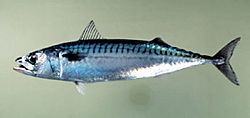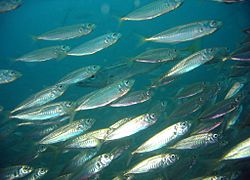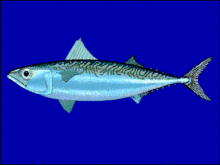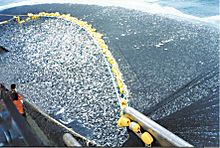Mackerel facts for kids
Mackerel is a common name given to a number of species of fish. Most mackerel are from the Scombridae family.
They are pelagic fish, found in both temperate and tropical seas. Most live along the coast or offshore in the oceanic environment.
Mackerel typically have vertical stripes on their backs and deeply forked tails. They are superb swimmers, but are often eaten by larger predators such as cod, sharks and dolphins.
Mackerel is an oily fish with rich of omega-3. The flesh of mackerel spoils easily, especially in the tropics, and can cause food poisoning. So, it should be eaten on the day of capture, unless pickled in salt, or refrigerated.
Characteristics

Most mackerel belong to the family Scombridae, which also includes tuna and bonito. Generally mackerel are much smaller and slimmer than tuna, though in other respects they share many common characteristics. Their scales, if present at all, are extremely small. Like tuna and bonito, mackerel are voracious feeders, and are swift and manoeuvrable swimmers, able to streamline themselves by retracting their fins into grooves on their body. Like other scombroids, their bodies are cylindrical with numerous finlets on the dorsal and ventral sides behind the dorsal and anal fins, but unlike the deep-bodied tuna, they are slim.
The type species for scombroid mackerels is the Atlantic mackerel, Scomber scombrus. These fish are iridescent blue-green above with a silvery underbelly and twenty to thirty near vertical wavy black stripes running across their upper body.
It might seem that the prominent stripes on the back of mackerels are there to provide camouflage against broken backgrounds. That is not the case, because mackerel live in midwater pelagic environments which have no background. However, fish have an optokinetic reflex in their visual systems which can be sensitive to moving stripes. In order for fish to school efficiently, they need feedback mechanisms that help them align themselves with adjacent fish, and match their speed. The stripes on neighbouring fish provide "schooling marks" which signal changes in relative position.
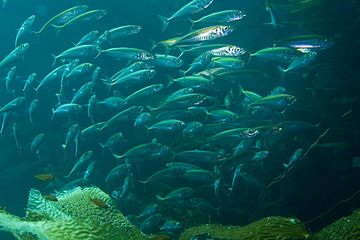
There is a layer of thin reflecting platelets on some of the mackerel stripes. In 1998, E J Denton and D M Rowe argued that these platelets transmit additional information to other fish about how a given fish moves. As the orientation of the fish changes relative to another fish, the amount of light reflected to the second fish by this layer also changes. This sensitivity to orientation gives the mackerel "considerable advantages in being able to react quickly while schooling and feeding."
Mackerel range in size from small forage fish to larger game fish. Coastal mackerel tend to be small. The king mackerel is an example of a larger mackerel. Most fish are cold-blooded, but there are exceptions. Certain species of fish maintain elevated body temperatures. Endothermic bony fishes are all in the suborder Scombroidei and include the butterfly mackerel, a species of primitive mackerel.
Mackerel are strong swimmers. Atlantic mackerel can swim at a sustained speed of 0.98 metres/sec with a burst speed of 5.5 m/s, while chub mackerel can swim at a sustained speed of 0.92 m/s with a burst speed of 2.25 m/s.
Distribution
Most mackerel species have restricted distribution ranges.
- Atlantic Spanish mackerel (Scomberomorus maculatus) occupy the waters off the east coast of North America from the Cape Cod area south to the Yucatan Peninsula. Its population is considered to include two fish stocks, defined by geography. As summer approaches, one stock moves in large schools north from Florida up the coast to spawn in shallow waters off the New England coast. It then returns to winter in deeper waters off Florida. The other stock migrates in large schools along the coast from Mexico to spawn in shallow waters of the Gulf of Mexico off Texas. It then returns to winter in deeper waters off the Mexican coast. These stocks are managed separately, even though genetically they are identical.
- The Atlantic mackerel (Scomber scombrus) is a coastal species found only in the north Atlantic. The stock on the west side of the Atlantic is largely independent of the stock on the east side. The stock on the east Atlantic currently operates as three separate stocks, the southern, western and North Sea stocks, each with their own migration patterns. Some mixing of the east Atlantic stocks takes place in feeding grounds towards the north, but there is almost no mixing between the east and west Atlantic stocks.
- Another common coastal species, the chub mackerel (Scomber japonicus), is absent from the Atlantic Ocean but is widespread across both hemispheres in the Pacific, where its migration patterns are somewhat similar to those of Atlantic mackerel. In the northern hemisphere, chub mackerel migrate northwards in the summer to feeding grounds, and southwards in the winter when they spawn in relatively shallow waters. In the southern hemisphere the migrations are reversed. After spawning, some stocks migrate down the continental slope to deeper water and spend the rest of the winter in relative inactivity.
- The Chilean jack mackerel (Trachurus murphyi), the most intensively harvested mackerel-like species, is found in the south Pacific from West Australia to the coasts of Chile and Peru. A sister species, the Pacific jack mackerel (Trachurus symmetricus), is found in the north Pacific. The Chilean jack mackerel occurs along the coasts in upwelling areas, but also migrates across the open ocean. Its abundance can fluctuate markedly as ocean conditions change, and is particularly affected by the El Niño.
Three species of jack mackerels are found in coastal waters around New Zealand: the Australasian, Chilean and Pacific jack mackerels. They are mainly captured using purse seine nets, and are managed as a single stock that includes multiple species.
Some mackerel species migrate vertically. Adult snake mackerels conduct a diel vertical migration, staying in deeper water during the day and rising to the surface at night to feed. The young and juveniles also migrate vertically but in the opposite direction, staying near the surface during the day and moving deeper at night. This species feeds on squid, pelagic crustaceans, lanternfishes, flying fishes, sauries and other mackerel. It is in turn preyed upon by tuna and marlin.
Life cycle

Mackerel are prolific broadcast spawners and must breed near the surface of the water due to the eggs of the females floating. Individual females lay between 300,000 and 1,500,000 eggs. Their eggs and larvae are pelagic, that is, they float free in the open sea. The larvae and juvenile mackerel feed on zooplankton. As adults they have sharp teeth, and hunt small crustaceans such as copepods, as well as forage fish, shrimp and squid. In turn they are hunted by larger pelagic animals such as tuna, billfish, sea lions, sharks and pelicans.
Off Madagascar, spinner sharks follow migrating schools of mackerel. Bryde's whales feed on mackerel when they can find them. They use several feeding methods, including skimming the surface, lunging, and bubble nets.
Fisheries
Chub mackerel, Scomber japonicus, are the most intensively fished scombroid mackerel. As can be seen from the graph on the right, they account for about half the total capture production of scombroid mackerels. As a species they are easily confused with Atlantic mackerel. Chub mackerel migrate long distances in oceans and across the Mediterranean. They can be caught with drift nets and suitable trawls, but are most usually caught with surround nets at night by attracting them with lampara lamps.
The remaining catch of scombroid mackerels is divided equally between the Atlantic mackerel and all other scombroid mackerels. Just two species account for about 75% of the total catch of scombroid mackerels.
Chilean jack mackerel are the most commonly fished non-scombroid mackerel, fished as heavily as chub mackerel (see second graph on the right). The species has been overfished, and its fishery may now be in danger of collapsing.
Smaller mackerel behave like herrings, and are captured in similar ways. Fish species like these, which school near the surface, can be caught efficiently by purse seining. Huge purse seiner vessels use spotter planes to locate the schooling fish. Then they close in using sophisticated sonar to track the shape of the shoal. Entire schools are then encircled with fast auxiliary boats which deploy purse seine nets as they speed around the school.
Suitably designed trollers can also catch mackerels effectively when they swim near the surface. Trollers typically have several long booms which they lift and drop with "topping lifts". They haul their lines with electric or hydraulic reels. Fish aggregating devices are also used to target mackerel.
Images for kids
-
Still life with mackerel, lemon and tomato, Van Gogh, 1886
See also
 In Spanish: Verdel para niños
In Spanish: Verdel para niños


